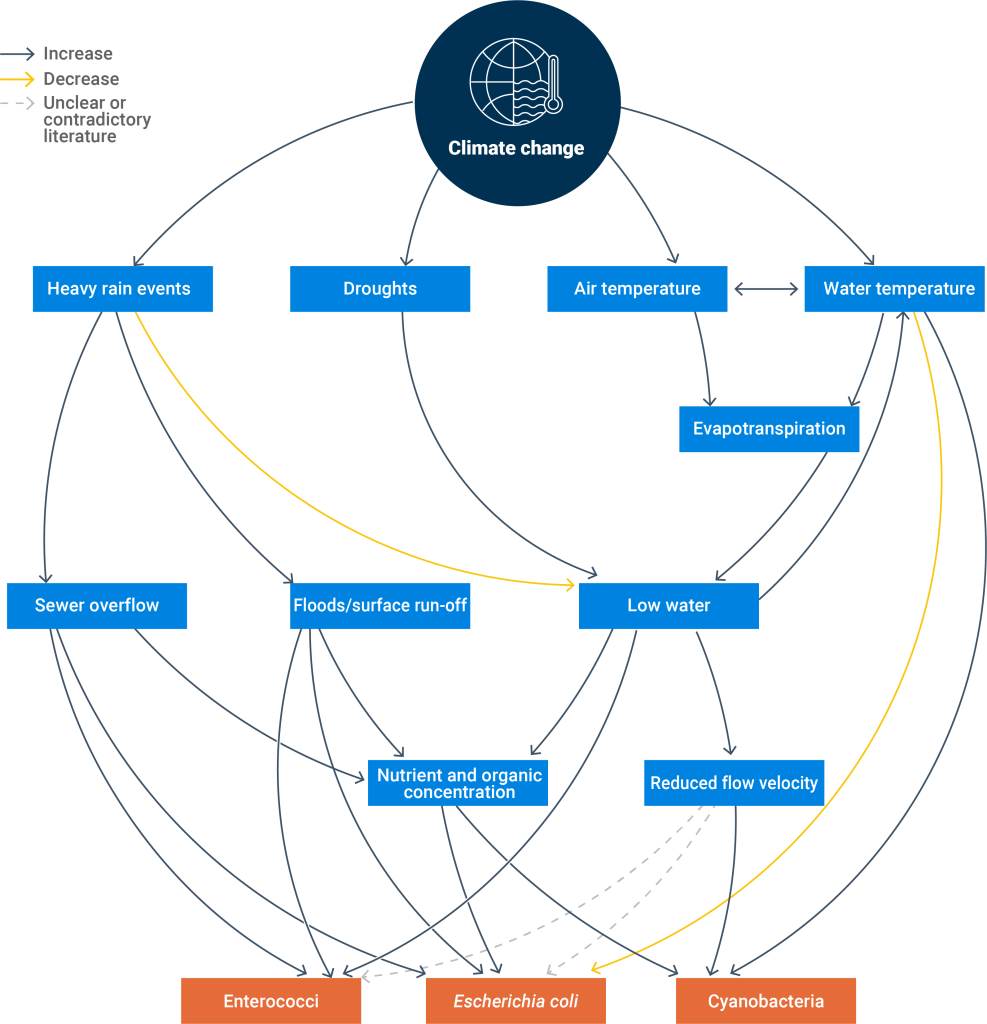Across Europe, from the Atlantic Ocean, the Mediterranean Sea to the Adriatic Sea, the bathing water quality in most areas is considered to be high for swimming. This assessment is based on two key indicators, Escherichia coli (E. coli) and intestinal enterococci, as mandated by the Bathing Water Directive (EU, 2006).
Yet, in the long-term management of coastal areas, potential problems are lurking in the near future. With the ongoing effects of climate change taking hold, along with the accelerated urbanization of coastal areas and the increase in tourism activities, additional pressures on the environment are emerging. Particularly important are dynamic sources of pollution, such as those originating from maritime transport activities.
Conceptual model of the relationship between climate warming and the occurrence of E. coli, intestinal enterococci and cyanobacteria (Source: EEA):

Besides the ongoing impacts of climate and human-induced changes on the quality of bathing sites, a question arises as to whether the usual classification of ‘bathing’ sites is sufficient to ensure public health, given that citizens and tourists swim in various undesignated locations.
To resolve this issues and build resilience capacities on national level in Croatia, The Croatian Institute of Public Health (HZJZ), along with the regional Adriatic Institutes for Public Health of Primorje-Gorski Kotar, Istria, Split-Dalmatia, Zadar and Lika-Senj counties, have partnered with us for our innovatively designed project called the ‘Coastal Anthropogenic Pollution Risk Identification’.
Utilizing an advanced technological system based on artificial intelligence, satellite monitoring, and systematic, and strategic sampling, the partners aim to enable more accurate identification of pollution risks caused by human activities in coastal areas, contributing to the preservation of our coasts and seas. More than 700 locations along the Adriatic coastline are already included, with the aim of expanding to more than 1500 within the next three years.
This represents an unprecedented geographical and hydromorphological diversity in training sets for artificial intelligence, ensuring that the model can be adapted to various future trends.
The key advantages of this project include:
- broader geographical coverage
- more frequent and precise monitoring
- dynamic pollution tracking
- development of predictive capabilities
- quick integration of newly identified pollutants
- enhanced resilience to climate change
- expansion of technology to monitor air and land
- support for tourism and the blue economy as a whole
With the help of SeaCras satellite technology, HZJZ and other national and regional institutions will now be able to collect data more efficiently and frequently, even from remote or hard-to-reach areas such as islands. This will help ensure the protection of the health of residents and visitors, allowing for quicker responses in case of pollution detection, such as the presence of harmful bacteria like E. coli or intestinal enterococci (e.g., E. faecalis).
We are extremely proud of this national-level project, which marks a new chapter in monitoring bathing sites water quality, on top of the traditional sampling-based monitoring. The goal is to establish the new standard for large-scale monitoring and the adoption of climate security principles to ensure public health in the long term to citizens, tourists, and other guests across Croatia.
The project is aligned with Directives, namely:
Marine Strategy Framework Directive
Water Framework Directive
Urban Waste Water Treatment Directive